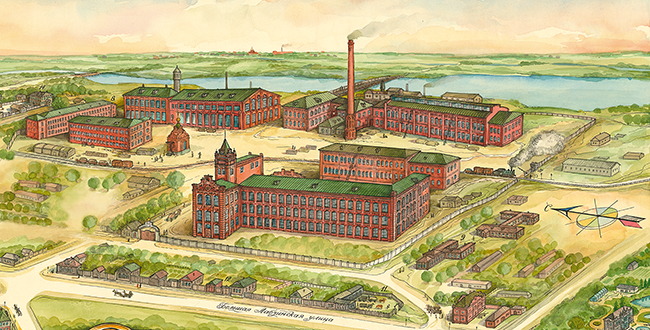From roots to nowadays

The shawl company is more than two centuries old. But the world-famous Pavlovo Posad kerchiefs and shawls were not in production from the very beginning. Their manufacture was established by the merchants Y. I. Labzin and V. I. Gryaznov in the early 60s of the 19th century after the foundation of the factory.
At the time, more than 70 silk kerchief factories owned by peasants were located in the Bogorodsky district of the Moscow province, to which Pavlovsky Posad historically belonged. Among them was the silk factory of a peasant from the village of Pavlovo («Vokhna tozh»), Ivan Dmitrievich Labzin, founded in 1795. However, such enterprises were called factories in official terminology only, although they were mostly weaver attics where manual labor was used. The factory of the Labzin peasant of Pavlolvo was no exception: it employed about a dozen free employees making «mediocre» and «bad quality» silk handkerchiefs.
The enterprise was evolving and growing rich year after year. Generation after generation, the Labzin owners also were growing rich together with it. However, having remained in the peasant class for a long time, only the grandchildren of Ivan Labzin joined the merchant class because of the need to conduct trade «in different cities». By the middle of the 19th century, the enterprise passed to his great-grandson Yakov Labzin, who, together with his partner Vasily Gryaznov, reoriented the factory for production of woolen shawls with printed patterns.
By that time, shawls became a part of everyday life of various strata of the Russian society, becoming a characteristic element of the Russian costume — first that of noblemen, and later of merchants and peasants. Shawls became particularly widespread in the middle of the 19th century, when many manufactories and factories established production of cheaper shawls with printed patterns compared to the woven ones. The partners had to work in conditions of fierce competition: at that time, the products in demand were produced at many factories, the most powerful of which were concentrated in Moscow and the Vladimir province. Nevertheless, merchants from a small town near Moscow managed not only to survive, but also to take their special place in the commercial expanses of the Russian Empire thanks to their talent and vigor.
The fact that in 1861 the factory workers included calico printers, carvers, pyrographers, perrotine workers, 2 colorists and even 3 draftsmen: Ivan Ivanovich (Ivanov), Mikhail Ilyich (Sudin), Ivan Vasilyevich Sorokin — suggests that a new production at the Labzin-Gryaznov plant was fully mastered by the beginning of the 1860s.
A smaller silver medal received for «Good Weaving and Printing of Muslin-de-Ligne and Kerchiefs» at the Moscow exhibition of Russian manufactory works of 1865 speaks about the successes of the new production of Y. I. Labzin and V. I. Gryaznov.
Handkerchiefs of the 1860s are the earliest of the Pavlovo shawls to survive to this day. Their belonging can be accurately determined by the markings on the reverse side of kerchiefs — a stamp indicating the enterprise and the manufacturing time.
In 1869, V. I. Gryaznov died, but the representatives of the Labzin and Gryaznov families had always stood at the head of the factory until the October Revolution.
The 1870-1880s may be characterized as heydays of the shawl manufactory. In 1881, Yakov Labzin was appointed as a supplier of Her Majesty Great Princess Alexandra Petrovna «with the right to have a monogram of the name of Her Imperial Highness on signboard». In 1870 and 1882, the company was awarded silver medals of the All-Russian Art and Industrial Exhibitions. During the second half of 1880s, the process of a peculiar democratization of the Pavlovo Posad shawls begins. Shawls are widely used not only by nobles and merchants, but also gain popularity among the middle class and wealthy peasants.
In the early 20th century «The Y. Labzin and V. Gryaznov’s Manufactory Partnership» employing 2000 people was the largest enterprise in Russia among those producing woolen shawls and kerchiefs. Storehouses were located in Moscow, Kharkov, Omsk, Romny, Uryupinsk, at the Nizhny Novgorod and Irbit fairs. The property of the association, including the cost of materials and goods, was measured at more than 4,300,000 rubles.
After the revolution, the Labzin-Gryaznov company was nationalized and became known as the Staro-Pavlovsky factory. In the first decades the main products were made from cotton due to a shortage of raw materials. Woolen shawls of those years were made mostly using the old pre-revolutionary models. In the mid-1920s, the factory tried to introduce new trends in the shawl design. There was an interesting experience of arranging a pattern using stylized images of animals (the Leopard shawl), revolution, industrialization and collectivization -themed patterns appeared. However, the leading place among the Pavlovo products was still occupied by shawls with traditional floral ornaments. This art movement found its most vivid embodiment in the works of N. S. Postigov, N. I. Chudin, K. E. Abolikhin. The names of these artists became a legend, and their works — the «classics» of the Pavlovo kerchief art.
In 1928, the merged Staro-Pavlovsky and Lensky factories took part in the 1st artistic textile exhibition held in Moscow. Woolen and semi-woolen shawls, printed and dyed, fundamental and cream, with silk and woolen fringes were included in the exhibition catalog as the products of the factory. In 1937, the collective of the factory prepared more than 600 items: shawls, covers, tablecloths, panels, etc. for the World Art and Industrial Exhibition in Paris.
The Great Patriotic War delayed the marked growth: the enterprise switched to the production of fabrics for the Red Army uniforms. However, by the postwar 1950s, the factory began producing printed pure woolen shawls again. After the Great Patriotic War, the printing production had to be restored. In the 1950s, the factory began producing printed shawls from pure wool. At this time, artists, the works of which in many ways determined the development of the Pavlovo handkerchiefs for subsequent decades, came to the factory. Yevgeniy Ivanovich Shtykhin returned after the war. In 1945, Ekaterina Petrovna Reginova began her work here after graduating from the Ivanovo Chemistry and Technology College. In 1950, Zlata Aleksandrovna Olshevskaya and Lidiya Sergeevna Shakhovskaya were transferred here in connection with the printing production transfer from the Lensky factory.
Along with the creation of new shawl compositions, the factory continued printing scarves according to old designs in the 1950s and 1960s, but with new color schemes, on fields of a wide variety of colors: ponceau, bordeaux, gold, light green, orange, green, turquoise, violet, etc.
The enterprise’s products were repeatedly exhibited at numerous domestic and foreign exhibitions. In 1958, Pavlovo handkerchiefs were awarded the Great Gold Medal at the World Exhibition in Brussels. You can find information about the latest history of the enterprise on the pages «About the Company» and «News».

